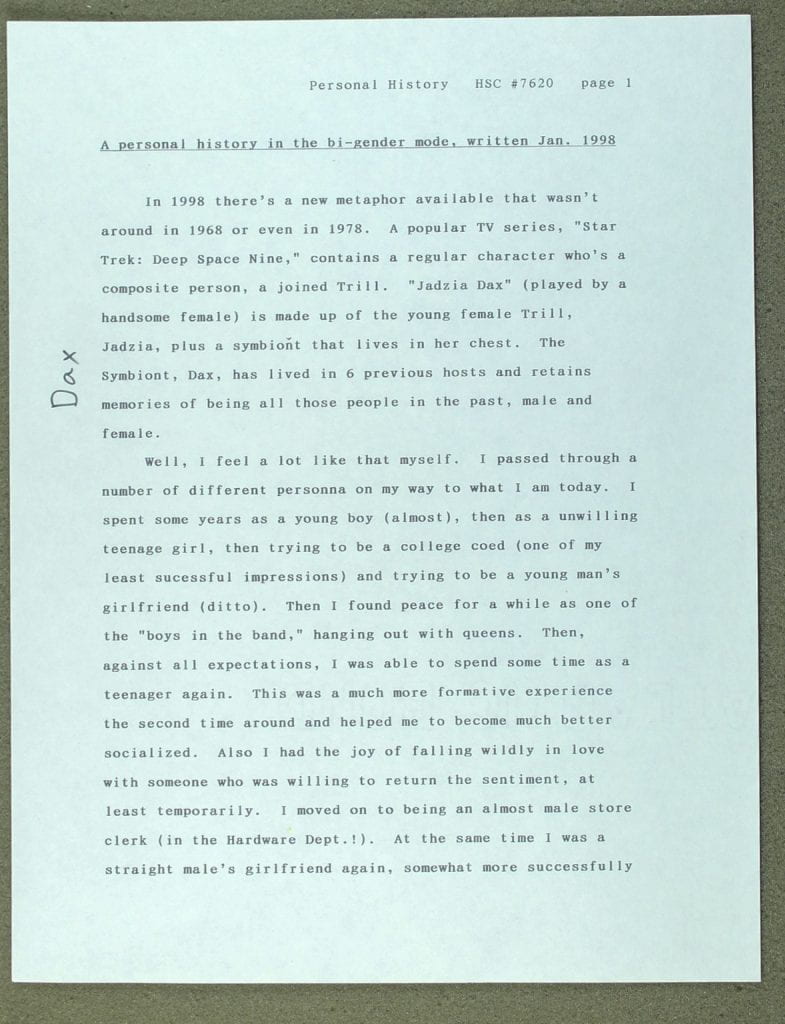by Travis Covitz, Class of 2022, Animal Science
In January of 1998, Pauline Layton wrote “A Personal History in the Bi-Gender Mode,” a 26-page essay on the varied relationship she had to gender since her childhood. One of the key points in her androgynous gender journey was the time spent at Cornell as a member of the new Student Homophile League (SHL). Layton was one of the first students to join not because they were in the social circle of founder Jerry Moldenhauer, but because of the public meetings the SHL started. When Moldenhauer later wrote to reflect on the beginnings of the SHL, he remembered Layton as a “bi-sexual.” In this personal history, Layton never describes herself as bisexual, although she was curious about sleeping with women and was definitely attracted to men.

A defining part of Layton’s Cornell experience that she describes was the conflict between her being perceived as a lesbian, due to her gender variance, and her desire for sexual intimacy with men. Androgyny – the possession of both masculine and feminine qualities – was a new concept for American culture in the late ‘60s and early ‘70s. Carolyn Heilbrun was an early academic to embrace the androgyne as the ideal person, as opposed to polarizing specialization of the sexes into different ideals. Women who chose to embrace androgyny – and, therefore, their own masculinity – were assumed to be lesbians, both by themselves and others. Layton faced this from classmates. Other women had difficulties holding both their attraction to men and honoring their masculine self-expression. Layton is not the only person to have a complicated relationship between gender expression and sexuality, and she was not alone in those feelings even in her early adulthood.
Through joining the SHL, Layton discovered some similarities in her life and those of gay men. Childhood bullying was a common background. Layton developed friendships with gay men, becoming one of the “queens,” over their shared interest in men as well as troubled experiences growing up. Interestingly, Layton also had sex with multiple gay men. Whereas other women distanced themselves from men and embraced lesbian separatism, Layton joined a group of masculine people whose lives focused on men.
Sources
Beemyn, Genny. “The Silence is Broken: A History of the First Lesbian, Gay, and Bisexual College Student Groups.” Journal of the History of Sexuality 12, no. 2 (2003): 205-223.
Gatherer, Haelen. “What Am I????” Women: A Journal of Liberation 4, no. 1 (1971): 30-31.
Moldenhauer, Jearld. “The Cornell Student Homophile League.” https://www.jearldmoldenhauer.com/wp-content/uploads/Cornell-Final5X.pdf
Sommella, Laraine. “Review: The Search for Androgyny.” Women: A Journal of Liberation 4, no. 1 (1971): 9.
After years of being involved as a local in Ithaca, both through political groups such as the Ithaca Tenant’s Union and working service industry jobs at ALDI and One Ring Donuts, Travis Covitz is now starting his career as a Lab Technician at the University of Rochester’s Medical School, where he plans to continue to be involved in local grassroots activism.
